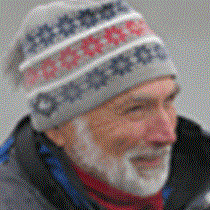We awoke heading south in Chatham Strait. Chichagof Island to the west wore a crown of cumulous clouds with high wisps of clouds far above. It was dry, bright and cheerful out, perfect for a short morning’s cruise before hiking and kayaking.
Most of our walks to Pavlof Lake were cut short by a feeding bear. The creek that flows out of the lake tumbles down about a 15-foot-high cascade and then spreads out onto a rocky intertidal area. In the last month of summer, most of the thousands of pink, sockeye, and Coho salmon are able to work their way up through the rocky maze to the lake and beyond. The best time for their journey is near the top of a high tide when they are the least exposed to the sharp claws and lethal teeth of a bruin. As we hiked along the shoreline, we soon encountered a brown bear making abrupt dashes that ended in sudden stops punctuated with flying water and quick movements as slippery salmon barely escaped with their lives. The easiest to catch were those that were slowed from the internal reconstruction of flesh to eggs. Many had just spawned and were struggling to merely stay in the current. Bears can be a fussy bunch, taking only those salmon that provide the highest caloric reward. They rip open the bellies for the eggs of some or bite out the brains of others. It is a raw and essential spectacle to behold. We were in awe, mesmerized by the eating habits of this great beast. The plans for our long, medium, and easier hikes were thrown into disarray. So we just watched, some in expedition landing craft and others in kayaks, while hikers sat on grassy knolls or peered down from elevated places among the spruces.
There is something very elemental about the continuing cycles of salmon. Every year they represent a bounty for bears, kingfishers, gulls, other fish, marine and stream invertebrates, shrubs and trees along the shores, not to mention mankind. They evade the bears, dig their redds, tenaciously guard the eggs, and persist until they are overtaken by the tiniest of currents. They then die and become part of the food web for possibly even their own offspring. Every year they are here like conductors and musicians in some grand symphony that plays endlessly.
Just before our lunch a brown bear and two cubs on the far shore were spotted from our anchorage. They disappeared into the forest and after a few minutes reappeared walking the opposite direction in the same track they had just passed through. Maybe they had no particular place to go. They wandered onto a beach. The mom watched the youngsters play and romp in the water near the shoreline. She soon lay down to watch with her chin on the beach. The cubs continued to wrestle. We went to lunch. Our undersea specialist, Justin, conducted a “live dive,” one that was transmitted in real time back to the ship. He could take questions and answer them as he looked for animals. Most notably there was an almost continual discovery of octopi along with numerous rockfish and anemones. The lounge was packed with fascinated guests. It was quite a comfortable way to take an Alaskan dive.
Just before our farewell dinner a double rainbow appeared, as if to underscore our adventure as it came to a close. Our great shipmates and lucky experiences truly made a voyage to remember.







